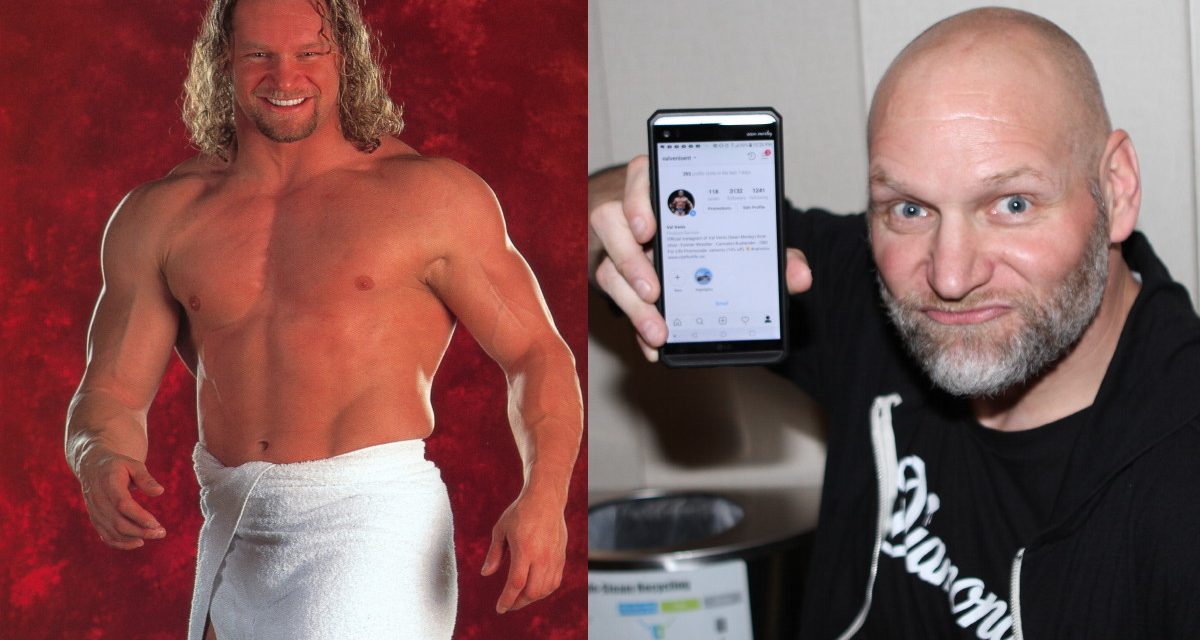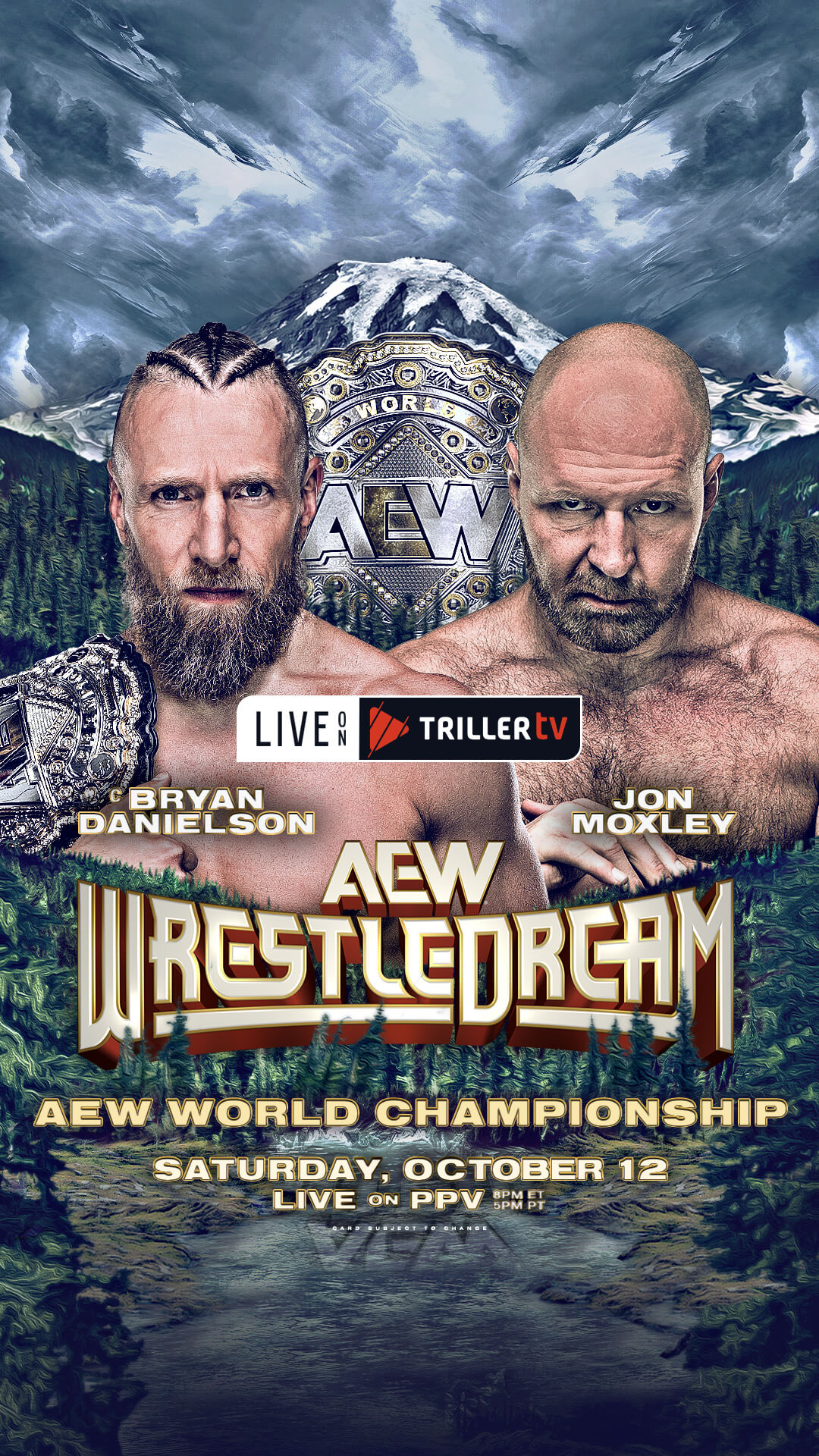Though he is most famous — and some would say infamous — for his role as Val Venis in the WWE, Ontario-born Sean Morley is actually one of the most-traveled Canadian wrestlers currently active in the industry, given that he has wrestled full-time in the United Kingdom, Mexico, Puerto Rico, as well as in North America.
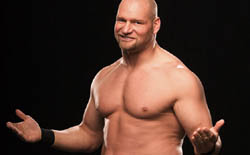
Val Venis in a 2008 WWE publicity shot.
Having been released from WWE in January 2009, Morley has just returned not only from his second tour of Japan for New Japan Pro Wrestling, but also from serious shoulder surgery, which sidelined him for the majority of 2008. It’s been a long process, but the time in Japan has helped to both eliminate any ring rust from his game, and also to gain the confidence in his body that the injury had eroded.
“When I had the major surgery on my shoulder, it was about eight months before I got released by the doctor to begin lifting weights again,” Morley told SLAM! Wrestling. “That was the injury that really set me back (Morley also had elbow surgery at the end of 2006) and I was consistently questioning if my shoulder would ever be the same again, and if I would ever be able to wrestle again. But after eight months and then beginning to lift weights — the longest I’ve ever had away from the gym — I realized that I’d be okay. I’m still not 100%, but I can see the strength coming back, and I can see the full range of motion coming back. So the question has pretty much been answered — my shoulder will be able to take the pressure of full-time wrestling again.
“New Japan have really taken care of me when I’ve worked there,” he added of his most recent ring time. “They are a phenomenal company, and since Giant Bernand (Matt Bloom) is one of my best friends and is a big star over there, working over there on a consistent basis is fantastic. They have some great talent there, like (Yuji) Nagata, who is always impressive, and Hiroshi Tanahashi is just a superstar, so smooth in the ring.”
Morley began his wrestling education all the way back in 1991, under the guidance of Dewey “The Missing Link” Robertson and his son Jason. Having attended both Big Time Wrestling and Maple Leaf Wrestling (operated by Bearman McKigney and the Tunney family respectively) shows in his youth, the dream of becoming a professional wrestler was always one that he felt within him. But even with all the will in the world, he never believed he’d have the physique to hang with so many of the top performers at the time.
“It was always a dream of mine to become a professional wrestler, but I never believed that I could really do it,” he said. “Back when I was a young child, and up until my high school days, I was always an athlete, and I played a lot of sports. My two main sports were motocross and freestyle skiing — mogul and ballet freestyle skiing. So I had motocross pretty much all spring, summer, and fall, and skiing in the winter, and plus I wrestled in high school, and played soccer and hockey and other sports, too. So I was an athlete, but a small athlete, and so I never thought I could be a professional wrestler because when I looked at that sport, I saw these huge guys.
“I guess probably when I was about 16, I got a real growth spurt, and so I became one of the tall guys in school, but I was real thin. It wasn’t until I started taking bodybuilding more seriously that I realized that I could at least learn how to do professional wrestling, so I could do local shows in Ontario. I had originally wanted to become a helicopter pilot, so I was going to study aeronautical science, and my plan was to do that and then, for fun on the weekends, do professional wrestling. So I trained with Dewey Robertson, although his son Jason really took over the training. Dewey was always a really good guy — a little off-the-wall, but with his wrestling character I suppose that was to be expected. Jason was really the one that set the foundation for me to build my career on, as far as the technical aspects of professional wrestling. When it came to the entertainment side, that’s was all Dewey.
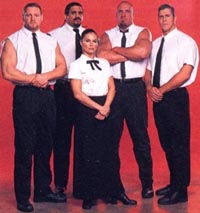
The Right to Censor faction: Val Venis, The Goodfather, Ivory, Bull Buchanan, Stevie Richards.
“Anyway, after I graduated high school, having done some independents I got full-time work wrestling in England. My plans then changed with the idea that I would wrestle there for the summer and then go back to the idea of being a pilot. But when I landed in England, I realized that I was big enough, athletic enough, and good enough to be a full-time wrestler. The passion and the love for the sport grew from the first couple of months I had there in England, and instead of being there for just the summer, I spent the entire year there. I’ve worked full-time as a wrestler ever since.”
Morley arrived on the British wrestling scene a little over three years after its final show on ITV, the second largest broadcast station in the entire United Kingdom. British wrestling’s popularity peak had been in the 1980s — when Big Daddy was not only a household name, but was one of the most famous sportsmen in the country — but when new ITV head honcho Greg Dyke decreed World of Sport wrestling as too low-rent for his liking (ratings remained excellent for what was a British tea-time institution), the sport was banished to satellite television, which was in a fractional number of homes at the time. Despite all of these problems, and the fact that his work was limited to small shows, Morley loved the lifestyle he found across the ocean.
“The British wrestling scene, to me, was phenomenal,” he explained. “I was working every day, sometimes twice a day, working all of the Butlins holiday camps. I was a young guy traveling around, getting to the next camp late at night when we could go out and party, getting up in the morning to set up the ring, doing the afternoon show, and then traveling to the next town. I had a lot of fun over there, living the dream, really. I was getting a ton of experience working against some really great guys, like Robbie Brookside and Doc Dean — guys who were absolutely phenomenal to work with. And of course, at the time, I was over there with my tag team partner Shane Sewell, who was in TNA and is currently wrestling in Puerto Rico. Shane is really one of my best friends in the business, along with Matt Bloom. He was an amazing tag team partner, certainly one of the best I’ve ever had.”
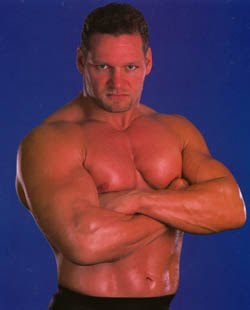
If I could be serious for a moment…
After England, Puerto Rico and Mexico came a-calling, and it was in the latter’s CMLL that Morley achieved one of his greatest successes, when he captured the company’s World Heavyweight Title from Rayo de Jalisco Jr. in April 1996. Then known as “The Steele”, Morley’s time working for promoter Paco Alonso was so important to him that even when the WWF offered him a tryout match (with Henry Godwinn), and eventually a job, he wasn’t prepared to drop everything, even at the whim of the biggest wrestling organization in the world.
“The experience I gained in Mexico, and Puerto Rico, was very important to me. I guess I could say I’m one of the lucky ones; I was a guy who was able to get into the industry and work full-time from day one, so I didn’t have to get on to the independent scene so much. A lot of guys would be lucky to get one show every weekend, whereas a slow week for me was five shows per week, and I was doing that for several years before I got into the WWE. You can’t help but get better working that kind of schedule, working with many different performers.
“But when I finally got the call to come in for WWE, it wasn’t like I dropped everything at that moment. If a promoter has always been done good business with me, and kept using me, I’ve been loyal. When the time did come to sign with WWE, Vince (McMahon) completely agreed with me that I should complete my bookings with CMLL. So what we did was I made a trip from Mexico to New York to pump out the vignettes, which we did in one day. I immediately flew back to Mexico, and while I was away, the vignettes aired on TV. In fact, for the first three or four months of my WWE contract, it was agreed with CMLL that I would just do WWE TV tapings, and that the rest of the time, I would spend working shows in Mexico. Both sides were gracious enough to work together on that, and it worked out really well for Paco, Vince, and myself.”
Far away from “The Steele,” a robot-style gimmick, Morley ended up as Val Venis, the well-endowed ex-pornography star. That fact was supposedly established when Jenna Jameson — possibly the most famous actress ever in the porn business — starred with him in the aforementioned vignettes that aired prior to his wrestling debut. For the then 27-year-old, the character was another dream come true, being somewhat of a fantasy for the teen male-dominated audience.
“I remember Vince calling me at 7 a.m. in the morning in Mexico and saying (imitating McMahon’s booming voice), ‘Sean, this is Vince McMahon!’ He said that he wanted to run an idea past me, to see if I was happy to go with it. To cut a long story short, it was to ask if I would mind being a character who was a former porn star turned wrestling star. What guy wouldn’t want to play a former porn star?! Like I’m not going to feel comfortable playing that! As soon as he threw that by me, I knew it would be something that would make an immediate impact with the fans, and something that would be a lot of fun to work. And it really was.”
After a memorable opening program with Kaientai (former Michinoku Pro lightweights Dick Togo, Sho Funaki, and Taka Michinoku, managed by longtime Gong writer Wally Yamaguchi), it was not long before Venis was wearing WWF gold, defeating Ken Shamrock for the Intercontinental Title at the St. Valentine’s Massacre pay-per-view on February 14, 1999. Just months later, however, the breakout year was clouded by the tragic death of Owen Hart at the Kemper Arena in St. Louis at the Over the Edge PPV. But like so many people who worked with the youngest member of the Hart family, there is always a story in mind that will at least mean that Hart will never be forgotten.
“Owen’s death reminded me of how quickly life can be stuffed out; you just don’t know what is around the corner tomorrow,” Morley somberly recalled. “Today it’s still shocking, and that night I was to be the match after Owen’s, and when he was on the stretcher he was actually wheeled right by me in the Gorilla position, and his eyes were wide open. I knew there that he was no longer with us, and to go out there and perform after seeing that was real hard. And of course, Jeff (Jarrett, who Morley wrestled on the show) being pretty much best friends with Owen, that was a real hard time for him. Owen was really someone that we can ever erase from our memories.
“There is one great Owen rib that he pulled on me. We flew into St. Louis airport one night, really late, and all got our rental cars to get us to the Marriott across from the airport, where all of the boys got in line to check in. So of course the lobby of the hotel is completely packed with fans who have pictures and merchandise for us to sign, and so you’ve got kids coming up to us and asking us to sign while we’re waiting to check in.
“So we’re doing that and one guy comes up to me, and he’s got a stack of about 200 Val Venis pictures, and he says ‘Hey man, can you sign these for me?’ and I look at him and say ‘Are you insane? I’m not signing all of those for you.’ So I turned back around and started signing for the kids that were around, and that guy disappeared. So eventually I check in, and I plan to crash out for a couple of hours, get up and go to the gym, and then eat and go to the arena.
“Just as I start to doze off, the phone in my room rings, and the voice on the other end of the phone says ‘Hey man, you promised you were gonna come down here and sign these 200 pictures for me!’ And so, I’m immediately thinking that this is the same guy, and I say, ‘Dude, I told you, I’m not going to sign those pictures, and I don’t appreciate you calling my room when I’m trying to sleep,’ and then I put the phone down. But he immediately calls back and says, ‘Hey man, when you make a promise to sign 200 pictures, you better hang on to that promise. You need to get your butt down here right now and sign these pictures!’
“So I say, ‘You son of a bitch, you call my room one more time, I’m gonna kick your ass!’ and he responds back ‘I’m a big man, you won’t get by me!’ So finally I say, ‘You wait right there!’ and I throw my clothes back on and run down the stairs of the hotel, not even waiting for the elevator. I ran into the lobby, which is pretty much empty at this point, and Owen and Jeff are sitting on a bar stool, even though the bar is closed. I ask them if they’ve seen this guy with the big stack of pictures, and they say ‘I think I saw him go outside,’ so I go running out the door, but I can’t find him.
“So about six months later, Edge and I are in Toronto, and we’re getting ready to do Off The Record with Michael Landsberg. We’re talking about Owen, and Edge says, ‘Hey Val, do you remember in St. Louis when you were gonna kick the ass of the guy with the pictures? That was Owen.’ My heart just sunk — the guy got me! I’d been telling everyone this story of how this idiot had called my room, and I had ran down trying to find him, but it was Owen all along (laughs).”
After defeating “British Bulldog” Davey Boy Smith for the European Title in December 1999, and subsequently losing it three months later to Kurt Angle, it was time for the Val Venis character to go in a different direction. A complete 180° direction, as it happened, as the characters of Venis and The Godfather both instead became a part of the Right to Censor group, which was scripted to make fun of the Parents’ Television Council, an organization who seemed hell-bent on bringing down the WWE due to their questionable content of the time. Quickly, Morley saw this as a short-lived twist on the Val Venis gimmick, and had concerns about its future thereafter.
“I really liked the Val Venis character, though I would have liked to have seen him move away from the ‘stealing the woman’ storyline, and into more of a championship status. At that time, the PTC were really hammering the WWE’s advertisers, and I remember having a conversation with Vince where he was very concerned about the PTC. They were trying to force WWE to tone down two characters in particular: The Godfather and Val Venis. So eventually, with all the pressure from the advertisers and the PTC, my belief is that they took the two most over-the-top, envelope-pushing characters and did the opposite with them in order to poke fun back at the PTC. I enjoyed it, we got heat with it, and it was entertaining, but I knew that it would be a short-lived deal. The RTC were not characters created for championship purposes; they were created for a short entertainment spurt for that particular situation. I was concerned about dropping the Val Venis character, and then when it came back to being Val Venis again, we couldn’t pick it back up.”
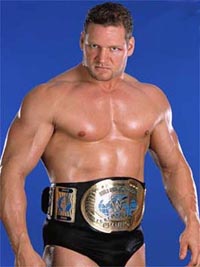
Intercontinental champion Val Venis.
The character’s direction ended up being the least of Morley’s concerns in 2002, however, when a weight machine failed during one of his heavy lifting sessions at the gym. It was a frightening time not just for Morley, but for his wife, who witnessed the accident, and there was initially concern about potential spinal damage that the accident may have caused. Thankfully, after an eight-week lay-off, Morley was able to return to the ring.
“Basically what happened was that an entire pulling machine came tumbling down on my head,” he recounted. “It was real bad. From what I understand, the bolts that were securing it to the floor had rusted enough to the point that when I was pulling the stack, and the bolts snapped, and the entire thing with the 300 pounds up in the air, snapped and fell on to my head. So it was a scary moment.
“We were all pretty scared when it happened. My wife was in another part of the gym at the time, up on a balcony looking down on the weight machines, and she saw the whole thing happen. I just remember getting to the third or fourth rep, and then it was lights out. I remember a whole bunch of the other members of the gym trying to pull the machine off me, and my wife standing just above me screaming. I was probably out cold for a full 20 or 30 seconds.”
Having drifted somewhat since the beginning of the Right To Censor group, the Val Venis character was abandoned completely in the latter part of 2002, when Morley began working under his own name, as General Manager Eric Bischoff’s “Chief of Staff.” After the hardships that he had faced in trying to forge a true place for his character, not to mention the in-gym accident, Morley was delighted to have found a new challenge, even if it did not last as long as he would have liked.
“I have to say, I loved working with Eric Bischoff. I liked it so much that I’d like to work with him again in the future, maybe on a different project. He’s a very intelligent guy, and he’s inspiring. He’s like another Vince McMahon; he sees a goal, has the desire to attain it, and goes after it. To have people like that to look up to, and to learn from those type of people, is a great thing. I’d love to learn from him in the future.
“I think that the Chief Morley character was actually quite strong, and it was beginning to gather steam. However, after Steve Austin had all of his neck injuries and couldn’t wrestle, the only spot that they could put him back in effectively was in the spot as co-owner with Eric Bischoff. The Chief Morley character would have convoluted that storyline, and that’s why they sent me back to being Val Venis.
“But because everything was moving to more PG rated, I started working more with the young guys. For example, I worked with Bobby Lashley for a few months before he started on TV. Chris Masters, again for several months before he started on TV. It was like, ‘Let’s have him work with Val and see how he comes along.’ So I ended up being a kind of gatekeeper for the new talent. And I enjoyed it as well; Chris Masters and I became very good friends, and Bobby Lashley was a super nice guy and would try anything in the ring. In fact, we would try different finishes every night for him at the house shows. So I loved working with the young guys, but deep down there was also a desire to get back into the mix of things, and really make an impact.”
The chance to make a really significant impact was not truly forthcoming, however, though Morley continued to work steadily in the self-titled gatekeeper role until the beginning of 2009, when he suffered the aforementioned shoulder injury. The recuperative time has allowed him to pursue some of his other interests, including in political discussion, in which he has some very strong libertarian views. So much so, in fact, that he has started his own Libertarian blog and has authored several books on the subject, the first of which he hopes to publish in the very near future.
“’Freetarian’ is just a word that I came up with — I’m a Libertarian and very much pro-freedom and liberty, and pro limited government. Being someone who loves true freedom and liberty, I decided to use the first part of the word ‘freedom’ and combine that with the last part of Libertarian, to create my own word. At first it was just something funny I came up with, but it caught on.
“When I came out of high school, I guess you could say that I was a left-wing socialist, even if I wasn’t all that interested in politics at the time. I was taught in the public education system and you’re really only taught what the government wants you to be taught. For example, by the time that I came out of high school, I had already been taught to believe that Canada had the greatest health-care system in the world, and that we didn’t want the American style of health-care because they let people die on the gurneys if they don’t have the money or the insurance. But once I moved south, I was a little fearful at first, but when I bought my own insurance, I could go to any doctor I wanted, at any time I wanted, or I could go and see a specialist if I wanted. I could get an MRI the same day if I wanted. Soon I began to question everything that I’d been taught about the health-care system, and realized that I’d be lied to my entire time there, through the teaching in school and through the government-licensed media.
“That’s when I started and sit down and think about what else I’d been lied to about, and I started to study freedom and liberty, and it was like the gates of hell had opened up as I realized that all of it was corrupt. There isn’t one thing that a government does, that it doesn’t do through coercion, intimidation, and force. That’s incompatible with freedom, incompatible with liberty, and incompatible with what the founding fathers of our country wanted. The government can indoctrinate anything it wants into its citizenry. It’s a scary thought.
“So I’ve got three books about these subjects, which I’ve been working on for the last few years. I’d love to sit down and finish the first book, which really hammers the freedom and liberty aspect of all the important issues America and Canada are facing today. In the near future I’m going to be looking for a publishing house to pick that up, I’ll be updating my blog, and I’ll be doing some independent wrestling shows, maybe even over in Europe in the summer. I’ll be touring Japan again soon, and I also have a T-shirt store I’ve just opened — I love designing funny political T-shirts and things like that. As well as that, people were always asking me to put custom greetings on their cellphones, so I’ve started to do that for people as too. It’s kinda neat and a lot of fun.”
With all of that, Sean Morley has a lot on his plate, no doubt enough to occupy him fully right the way through to the end of 2010. With the diverse areas in which he’s currently plying his hard-working craft, not to mention all of the territories in which he has previously wrestled, one can only wonder which of his many interests benefit from his services after that.
RELATED LINK
